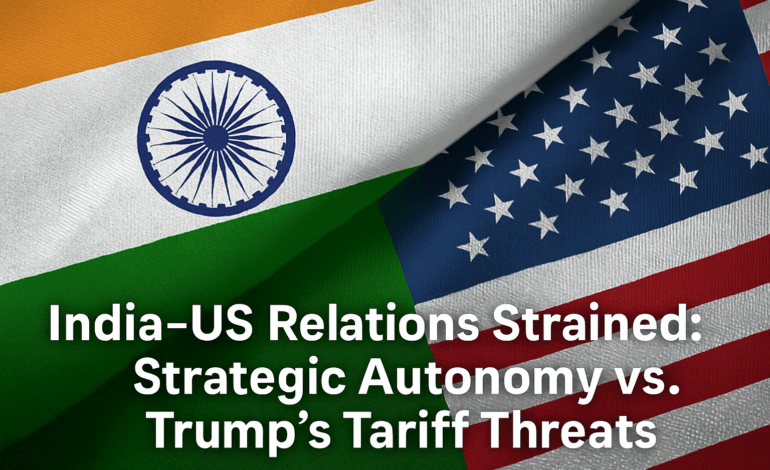
Where are Indo-US relations headed? India’s strategic autonomy vs. Trump’s tariff threats
By: Dr Avi Verma
Just six months into President Donald Trump’s second term, the Indo-US relationship is facing perhaps its most serious challenge in decades. With tariffs on Indian imports now raised to a staggering 50% and the threat of secondary sanctions looming, New Delhi is grappling with a reality far removed from the warm optics of Trump-Modi summits and “Howdy Modi” rallies.
At the heart of this rupture is a sharp divergence over India’s continued purchase of Russian oil—a move that the Trump administration deems unacceptable amid its renewed efforts to isolate Moscow over the war in Ukraine. When asked why India, and not others, was targeted for sanctions, Trump responded with characteristic bluntness: “You’re going to see so many secondary sanctions.”
The punitive tariff hike, and the veiled threat of broader penalties, raise a deeper question: Can India hold its ground—and should it?
Tariffs, oil, and a test of sovereignty
India imports nearly 2 million barrels of crude oil daily from Russia, driven by discounts and long-term energy security calculations. For a country of 1.4 billion people, affordable and reliable energy is not a luxury—it’s a necessity.
Yet Trump’s administration sees it differently. A 25% tariff was initially slapped on Indian goods last month; this week, another 25% was added. The justification? That India is helping fund the Russian war machine—an assertion that oversimplifies complex global energy dynamics and ignores Europe’s own deep trade ties with Moscow until very recently.
India’s Ministry of External Affairs called the tariffs “unfair and unreasonable,” citing “market factors” and its energy needs. The ministry also pointed out the double standards of the West: Europe imported more from Russia in 2024 than India did, and the U.S. still trades Russian fertilizers and chemicals.
So, should India be worried about the reasoning behind these tariffs? Perhaps—but not for the reasons Trump imagines.
The danger is not India’s reliance on Russia but Washington’s misreading of India’s geopolitical compulsions. Trump’s actions risk turning a stable and increasingly vital bilateral relationship into a transactional one, driven more by arm-twisting than by mutual respect.
Strategic autonomy is not a bargaining chip
For decades, India has walked a tightrope, balancing relationships with the U.S., Russia, and emerging powers like China. Its foreign policy doctrine—strategic autonomy—has withstood the Cold War, sanctions, and shifting global alliances.
To think India would now abandon that stance under pressure is naïve.
New Delhi’s ties with Moscow are not merely transactional. Russia is India’s largest defense supplier and a long-term energy partner. Additionally, India has joined the BRICS alliance, co-led by Russia and China, and recently reopened channels for a trilateral dialogue between these powers.
Despite this, India has also dramatically deepened ties with Washington over the past two decades—on defense, tech, intelligence-sharing, and education. But none of these alignments mean subservience.
India’s policymakers understand this well, and Prime Minister Narendra Modi’s defiant words—”We will buy only that which is made by the sweat of an Indian”—should not be dismissed as rhetoric. They reflect the mood of a country unwilling to yield to threats, even from a superpower.
Trump’s approach: Tactical gambit or strategic misstep?
If this is Trump’s strategy to pressure India to isolate Russia, it may backfire.
Former Indian diplomats and Western analysts alike agree that India will not give up its Russia relationship just to please Washington. And as Trump also toys with penalizing China, his administration risks alienating two of Asia’s largest economies at once—while simultaneously cozying up to Pakistan’s military leadership, even hosting their army chief at the White House.
India also remembers the shackled deportations of Indian nationals earlier this year and Trump’s repeated attacks on H1B visa holders—most of whom are Indian. His calls for U.S. tech companies to stop hiring from India have only added to the growing discomfort in New Delhi.
This isn’t just hardball politics. It is a pattern of unpredictability that weakens trust and undermines the very foundation of the strategic partnership both nations have painstakingly built.
India’s best move: Steady, principled diplomacy
Amidst this turbulence, India has shown maturity.
It has neither retaliated in haste nor capitulated to pressure. Instead, it is doubling down on strategic dialogue—NSA Ajit Doval has visited Moscow, External Affairs Minister Jaishankar is preparing for another Russia trip, and President Putin is expected in India later this year.
India knows that short-term punishment does not warrant long-term policy surrender.
What it does require, however, is a renewed push to diversify trade relationships, bolster regional partnerships like the Quad, and strengthen domestic resilience to external shocks.
Conclusion: Partnership on the edge
Trump’s tariffs may not break the India-U.S. relationship, but they’ve certainly bruised it. The current situation calls for level-headed diplomacy, not loud threats.
India should continue to assert its strategic autonomy without burning bridges. Washington, on the other hand, must decide whether it wants to treat India as a true partner—or as just another pawn in its global power games.
In the long run, partnerships thrive not on pressure, but on mutual respect, shared goals, and trust.
If Trump forgets that, India will not. And it will not bend.